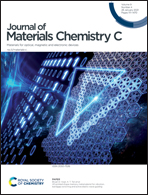Achieving pure yellow, high-efficiency (EQE > 20%) electroluminescence from ultrathin emitting layer (0.6–2.0 nm) OLEDs having a rare aggregation-free heteroleptic platinum complex†
Abstract
In this work, we newly synthesized a non-aggregating FBNNND platinum complex. From the single-crystal X-ray structure, it can be observed that the molecules of FBNNND are stacked into a column-like array with a very long Pt–Pt distance of 7.80 Å, which is ascribed to the non-planar and bended shape of coordinated ligand FBN and the steric hindrance generated from the substituents of the ligand. The emission spectroscopy study found that FBNNND emits nearly unchanged pure yellow photoluminescence (PL) in solutions (in the range of 10−5 to more than 10−3 M) and as a dopant in different hosted thin films. This is in sharp contrast to FPtOPhND, a classical heteroleptic platinum complex. FPtOPhND exhibits greenish yellow PL in diluted solutions, and red or even near-infrared emissions at higher concentrations or in doped thin films, an indication of aggregation, which is a typical behaviour of most platinum complexes. As an ultrathin emitting layer (0.6–2.0 nm) of FBNNND in organic light-emitting diodes (OLEDs), the same pure yellow electroluminescence (EL) having an external quantum efficiency (EQE) as high as 20.2% was achieved. Together with the crystal packing data, a further study using grazing incidence wide-angle X-ray scattering (GIWAXS) reveals that the molecules of FBNNND are aligned horizontally, which enhances the light outcoupling efficiency up to 32%, 1.6 times higher than ∼20% of conventional OLEDs.



 Please wait while we load your content...
Please wait while we load your content...